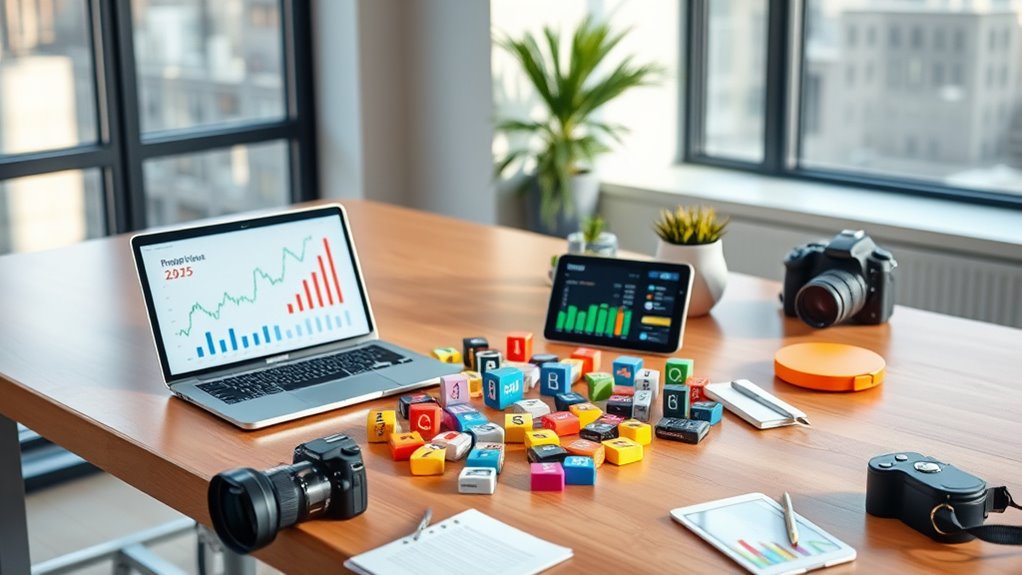To build a top personal finance app toolkit for 2025, focus on integrating real-time investment tracking with automated budgeting. Guarantee the platform syncs smoothly with various investment accounts, offers clear visual interfaces, and automates expense categorization to reduce manual effort. Use intuitive designs with accurate colors to enhance user experience and trust. By combining these features, you’ll create a powerful tool that helps users stay on top of their finances and reach their goals—more insights await if you continue.
Key Takeaways
- Integrate real-time investment tracking with budgeting automation for comprehensive financial management.
- Prioritize user-friendly, visually clear interfaces with accurate color schemes for better user experience.
- Incorporate secure, seamless platform integrations to automate data syncing and reduce manual entry errors.
- Enable customizable alerts, goal setting, and dynamic budget adjustments to adapt to changing financial situations.
- Focus on strong security measures, real-time updates, and intuitive design to build user trust and engagement.

Managing your finances can feel overwhelming, but a well-chosen personal finance app toolkit makes it simpler and more manageable. When you select the right tools, you gain better control over your money, streamline your financial tasks, and make smarter decisions. One of the key features to look for is investment tracking. This feature lets you monitor your various investments—stocks, bonds, mutual funds—in real time, so you’re always aware of your portfolio’s performance. With investment tracking, you can set alerts for market changes, analyze your asset allocation, and guarantee your investments align with your financial goals. Instead of juggling multiple accounts and manual updates, these apps sync directly with your investment platforms, saving you time and reducing errors. This way, you stay informed and can react swiftly to market movements. Additionally, incorporating features like high refresh rates ensures your data remains current and accurate, similar to the importance of refresh rates in home theatre projectors.
Budgeting automation is another essential element in a personal finance toolkit. Manual budgeting can be tedious and prone to errors, but automation takes the hassle out of managing your expenses. When you use apps with budgeting automation, your transactions are automatically categorized—groceries, rent, entertainment—giving you an instant overview of your spending habits. Many apps also set up recurring expenses and savings goals, automatically adjusting your budget as your financial situation evolves. This guarantees you stay on track without constantly updating spreadsheets or manually inputting data. Budgeting automation helps you identify areas where you might overspend, so you can make adjustments before it becomes a problem. It encourages discipline by providing real-time insights into your financial health and nudges you toward better money habits.
Combining investment tracking with budgeting automation in your app toolkit creates a thorough financial management system. You can see how your spending impacts your investment goals and adjust your behavior accordingly. For instance, if your budget shows excess spending in entertainment, you might decide to redirect those funds into your investment accounts. These integrated features empower you to make informed, proactive decisions, which is especially important in 2025 as financial markets and personal circumstances become more complex. The best personal finance apps for the year will prioritize user-friendly interfaces, security, and real-time updates, making it easier for you to stay organized and confident about your financial future. Moreover, understanding the importance of color accuracy can help you choose visually intuitive interfaces that enhance your user experience.
Frequently Asked Questions
Which Security Features Are Essential for Finance Apps?
You need to incorporate biometric authentication and robust encryption protocols to secure your finance app. Biometric methods, like fingerprint or facial recognition, add a layer of security, making unauthorized access difficult. Encryption protocols safeguard sensitive data both in transit and at rest, ensuring user information stays private. Combining these features helps protect user assets and builds trust, making your app more resilient against cyber threats.
How Do App Types Vary Across Different Income Levels?
Imagine a high-income individual using a premium app with advanced investment tracking, while someone with lower income opts for a simple budgeting tool. Income segmentation influences app types, leading to tailored features and interfaces. You can offer app customization based on income levels, ensuring users get relevant tools. This approach helps maximize engagement and usefulness, making your app more appealing and effective across diverse financial backgrounds.
What Are the Latest Trends in AI Integration for Finance Apps?
You’ll see AI personalization becoming more sophisticated, tailoring financial advice and alerts to your habits. Chatbot integration is also expanding, making it easier for you to get instant support and manage your finances seamlessly. These trends aim to create more intuitive, responsive apps that adapt to your needs, helping you stay on top of your finances with minimal effort. Embrace these innovations to enhance your personal finance experience.
How Can Apps Ensure User Data Privacy Compliance?
You can guarantee user data privacy compliance by implementing strong data encryption to protect sensitive information and regularly updating security protocols. Always obtain clear user consent before collecting or sharing data, and make privacy policies transparent and easy to understand. By actively enforcing these measures, you show your commitment to user privacy, helping your app stay compliant with regulations and build trust with your users.
Which Platforms Offer the Best Cross-Device Synchronization?
Did you know that over 85% of users expect seamless app experience across devices? For that, you should choose platforms with robust cloud syncing and broad device compatibility, like Firebase or AWS Amplify. These platforms guarantee your app syncs data effortlessly across smartphones, tablets, and desktops, providing a smooth, unified experience. Prioritizing these features keeps your users engaged and satisfied, no matter what device they use.
Conclusion
By 2025, your personal finance app toolkit will be your ultimate financial superhero, saving you from chaos and turning your money management into a breeze. With the right tools, you’ll conquer budgets, investments, and savings faster than a rocket ship. Don’t settle for ordinary — equip yourself with these powerful apps and watch your financial dreams skyrocket to epic heights. Get ready, because your financial future is about to become legendary!









